Out of all the river cruise itineraries in Europe, the ultimate is probably the Grand European Tour, which runs between Budapest and Amsterdam. Dan and I had fallen in love with river cruising during our Rhine River cruise, so when Viking River Cruises invited us to review their Grand European Tour, we couldn't resist. Five countries in two weeks, without changing hotels? Share it all with our readers? Heck, yeah!
Cruise days are full, so I kept a daily river cruise journal along the way. Our 15-day cruise became a series of stories that will tell you what you can expect every day and what you can do in each cruise port. There are articles about every stop on our river cruise itinerary. You'll find the links throughout this article.

What happens on a river cruise?
We've only been on two Viking river cruises so far, and the daily routine is generally similar. Every port of call begins with a guided tour of the city (included), after which you have leisure time to do whatever you fancy until the ship sails.
As for the lunchtime meal, some passengers return to eat on the ship. Others, including ourselves, prefer to stay in town and buy their own noontime meal. In our opinion, few things can match ordering local food in a local restaurant with local patrons. To us, it adds another layer to the experience of being in another culture.
At some stops, you may be able to join an additional tour. These special interest Viking excursions usually have a limited appeal, so they charge a nominal additional fee to cover the cost. It's a creative way to keep the basic price low, yet still add extra value to passengers. (Note: For the 2015 season, prices ranged between 29 and 64 euros per person.)
One thing about this cruise itinerary: Be prepared for a lot of scenery, culture, UNESCO sites, history and food. If you enjoy things like this, you will really enjoy the river cruising experience.
Viking Grand European river cruise itinerary
To give you a sense of the river cruise route, here is a map of our ports of call.
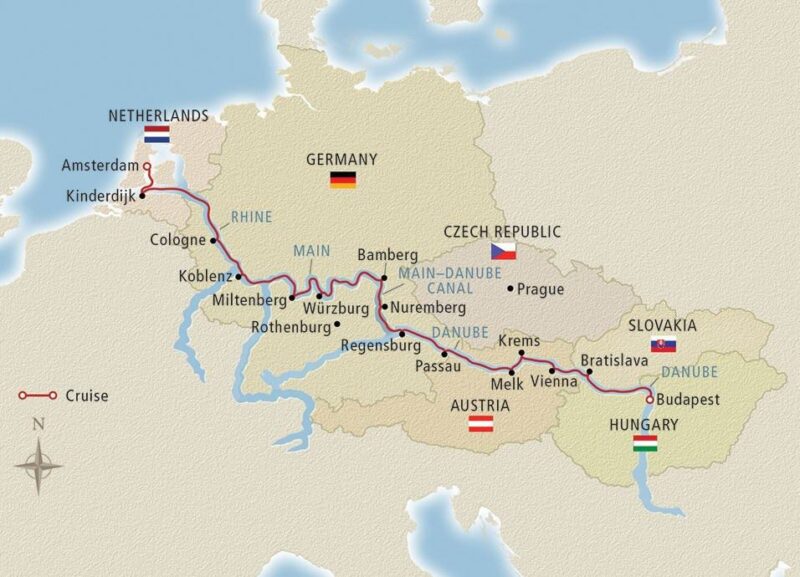
Now, let's get started on the Viking Grand European Tour itinerary! 😀
Days 1 and 2 – Budapest, Hungary
Day 1—Welcome aboard!
The recommended check-in time for a Viking river cruise is 3 pm. Travel schedules being what they are, Viking provides a light buffet lunch for passengers who can't help arriving early. You can read about the first day on a Viking cruise here.
The first Grand European Tour activity happens mid-afternoon. It's an unofficial guided walk around the area to help battle jet lag, should you be arriving the day of the cruise. You'll also have plenty of time to explore the area and pick up a few authentic souvenirs of Budapest.
Our Program Director promised that our first dinner on board would be special, and it was. They offered a traditional Hungarian menu, accompanied by local wines and beers. Many people don't know that Hungary has 22 wine regions and produces a number of excellent vintages. Tokaj and Bulls Blood are probably the best-known wines, and Hungary's Tokaj wine region is so phenomenal that it is a bona fide UNESCO site.
If Hungarian food isn't your thing or you need to selective about what you eat, no worries. They can accommodate many special diets and every menu includes a few familiar options, like grilled salmon and steak.
ⓘ TIP: If you enjoy good wine, pick up some local vintages along the way to enjoy with dinner. Unlike some river cruise lines, Viking doesn't charge a corkage fee.
Inspired? Pin this post and share it with your friends!
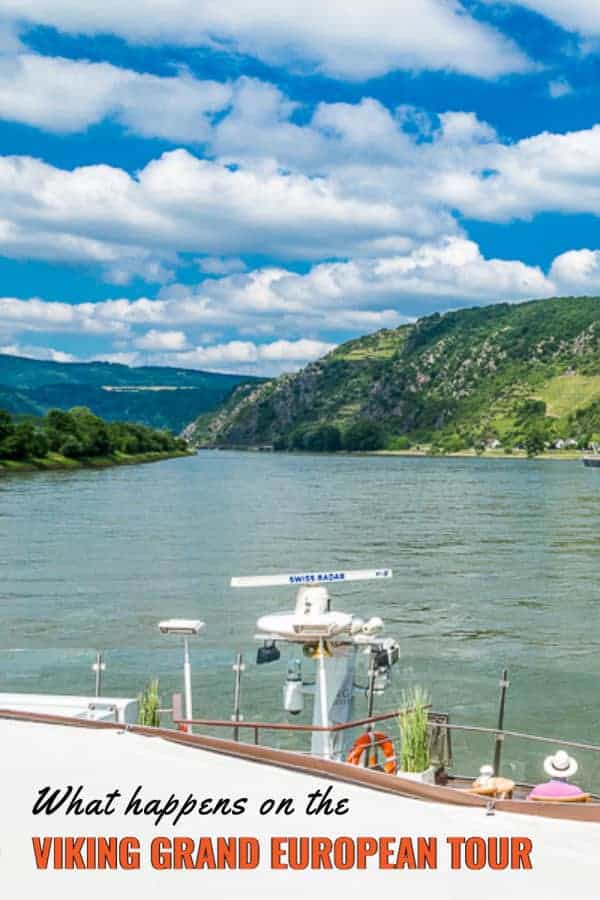
Day 2—Tour Budapest
Your first full day in Budapest begins with a morning tour. From Pest’s National Opera House and historic Heroes’ Square, we crossed over the Danube to the Buda side of the river. Oour tour took us along Castle Hill to Fishermen’s Bastion and Matthias Church. We also had some free time to explore before returning to the ship for lunch.
Your afternoon options are varied. Would you like to explore Budapest on your own or join an optional tour? Your choices are:
- Dohány Street Synagogue and Jewish Budapest (tour highlighting Budapest’s colorful Jewish past and present)
- Spa Experience (Budapest is famous for its therapeutic thermal waters and has the spas to prove it)
- Hungarian Horsemen: Lazar Equestrian Park (trip to see a horsemanship exhibition).

The second evening in Budapest began with a Welcome Reception. Consider it an official opportunity to chat with your Program Director and traveling companions.
The evening departure results in some phenomenal photographs. Evening cruising through Budapest on the Danube is spectacular. See our Budapest photos here.
Days 3 and 4 – Vienna, Austria

Viking has updated their itinerary since our cruise, dropping a day in Bratislava in favor of two days in Vienna. As much as we enjoyed Slovakia's capital, we left Austria's capital feeling as though we hadn't seen enough. Props to Viking for listening to passenger feedback and adding more time for visiting Vienna.
The Historic Centre of Vienna is a UNESCO site and there is plenty to see. We did see some of the city’s baroque architecture on our morning tour. Our guide made sure we saw the world-famous Opera House, St. Stephan’s Cathedral and Hofburg Palace, among other things.
Many of our fellow passengers spent the afternoon exploring Vienna on their own. If you do that, make sure to set aside some time to relax in one of Vienna's traditional coffee houses, just as the locals do.
We chose to take the optional afternoon tour to Schönbrunn Palace. It is called the “Versailles of Vienna” due to its massive size (1,441 rooms!), and it qualifies as a UNESCO site as well.
After dinner, we were treated to a classical concert (think Mozart and Strauss, not classic rock) performed by a Viennese orchestra. That's another optional tour; no need to endure it if you're not a fan.
Day 5 – Wachau Valley + Melk, Austria

Most cruising is done overnight, unless it's through a picturesque area. This morning we enjoyed some scenic cruising through the Wachau Valley, heart of Austria’s wine country. The Wachau is a stretch of the Danube Valley between Melk and Krems, and is of such unsurpassed beauty and historic importance that it has been named a UNESCO World Heritage Site.
The crown jewel of Melk is its abbey, an incredibly ornate 900-year-old Benedictine monastery. It features Austria’s finest Italian baroque architecture. Melk Abbey also has wonderful frescoes, as well as a library that holds an extensive collection of medieval manuscripts.
Day 6 – Passau, Germany

Passau is a town that lies where the Inn, Ilz and Danube Rivers meet. Our guided walk along the town’s narrow streets took us through Old Town and past many traditional patrician houses. Lying at the confluence of three rivers, Passau often experiences flooding, and one of the sights is where previous floods have left their mark.
We also saw the New Bishop’s Residence and the impressive baroque St. Stephen’s Cathedral with its ornate interior. If you arrive at noon, you can be treated to a special noontime concert on Europe’s largest church organ (17,000 pipes).
Then, free time to explore Passau on our own.
Day 7 – Regensburg, Germany

Regensburg is a wonderfully preserved medieval city. It's full of medieval architecture, dark and narrow lanes, and strong fortifications, and that's what makes it a UNESCO site.
We had a chance to tour the town’s market, city hall and the splendid St. Peter’s Cathedral, discover many 13th- and 14th-century patrician houses, and see ancient Roman, Romanesque and Gothic buildings.
Day 8 – Nuremberg, Germany

Our morning was spent on board, cruising to Nuremberg, Germany. Our program director offered a morning talk about the European Union, but Dan and I skipped it. We sat on our private stateroom balcony, sipping coffee and watching the passing scenery.
The afternoon options included a walking tour of the Old Town area. Highlights were the Albrecht Dürer House and Main Market Square. We drove by Zeppelin Field (the Nazi parade grounds of the 1930s) and the Palace of Justice, site of the infamous Nuremberg Trials.
World War II buffs can take an optional tour of the Documentation Center instead.
Day 9 – Bamberg, Germany

We spent the morning cruising through the 106-mile long Main-Danube Canal and passing through some of its 16 locks. Charlemagne first thought of continuous river travel from the North Sea to the Black Sea in 793, but it took until 1992—a whopping 1200 years—to actually accomplish his dream.
Once arriving in port, we were taken on a walking tour of Bamberg’s medieval city center. Bamberg has a magnificent 11th-century cathedral. However, it's best know for its picturesque city hall, built on a tiny island in the middle of a river.
When our guide released us to explore this UNESCO site on our own, a few of us asked for one final stop. Schlenkerla is a historic brewpub in Bamberg, Germany and is renowned for its smoked Aecht Schlenkerla Rauchbier.
Germany's Franconia region may be known for its wine, but Bamberg is famous for its distinctive, smoke-flavored beer. Truth be told, I enjoy smoky flavors so much that visiting the brewery is my favorite memory of Bamberg.
Day 10 – Romantic Road excursion to Rothenburg + Würzburg, Germany

Morning
Most passengers spent the day in Wurzburg. but we joined Viking’s optional Romantic Road excursion to Rothenburg ob der Tauber. The motorcoach ride was scenic, but it was drizzling and hard to see through the wet windows.
Rothenburg is a medieval town with charming half-timbered houses, a turreted city wall and impressive Gothic and baroque architecture. It ranks among one of the most picturesque in all of Germany. If you have a camera, you should really consider taking this tour.
Afternoon

After a traditional German lunch in a Rothenburg restaurant, we returned to Würzburg. The town is best known for the Bishops’ Residenz. One of Germany’s largest and most ornate baroque palaces, the palace is also a UNESCO site.
It's over-the-top elaborate, and hard to believe someone actually lived like this.
Evening
We had another delicious dinner on board. Viking had planned an evening glassblowing demonstration afterwards, but nope. The cruise director had to postpone it at the last minute because the glassblower missed the ship.
Oops.
Day 11 – Wertheim, Germany

Wertheim is located at the confluence of the Main and Tauber Rivers. It's a typical, small German town, with roots that date back to the 7th century. Wertheim is renowned for its glassblowing tradition.
Our walking tour included a visit to the historic marketplace and our guide pointed us to glassblowing studio that we could visit. Many passengers spent their free time in glass shops buying souvenirs. Dan and I preferred to leave the main drag and explore the old town's 1100-year-old back streets. (You can see our photos here.)
Down time in the afternoon. Time to relax on the sun deck with other passengers and watch the scenic vineyards of Franconia sail by. Dinner included some of the area's wines.
Tonight, we finally got our glassblowing demonstration. He was quite entertaining and kept us all laughing, especially when he drafted audience participants. The whole evening was super fun!
Day 12 – Upper Middle Rhine Valley + Mosel River + wine tasting + Koblenz

This morning was all about hilltop castles along a stunning stretch of the Rhine River. It's so special that the Upper Middle Rhine Valley has been designated a UNESCO World Heritage Site. There were plenty of oohs and aahs on the Sun Deck as we passed the dozens of castles and vineyards along its banks.
This was our second time in the Rhine Gorge and we enjoyed it just as much. The views are incredible and the associated commentary is fascinating!
Afternoon
The ship stopped in Braubach for a tour of one-of-a-kind Marksburg Castle. This castle is in perfect shape; it's the only Rhine fortress that has never been destroyed. Definitely a must-see.
As we had seen the castle on our previous Rhine River cruise, we opted to join a couple dozen other passengers for the optional Moselle wine tour. Our route took us along along the Mosel River, which offers a landscape of terraced vineyards punctuated here and there by typically German towns.
After stopping to stretch our legs at a very scenic overlook, we continued on to a Mosel winery. They took us into the inner sanctum of wine production and showed how they produced their wines. Then, of course, we sampled a few of their best.
Our ship docked in Koblenz until late evening. This is the picturesque town where the Moselle and Rhine converge. We ran into a group of crew members in town. They were enjoying a few hours off and invited us to join them.

Always inquisitive, we took the opportunity to ask about working for Viking. We figured they could speak frankly since we were off the ship, and we were right. Seems a few of them have worked for other river cruise lines or on ocean liners. Consensus: Viking has high standards, and they treat their employees better than the other companies did. Isn't that wonderful?!
Day 13 – Cologne, Germany

Cologne is Germany’s fourth largest city. Our morning walking tour through Old Town passed St. Martin’s Church, the Renaissance city hall and the remnants of an ancient Jewish mikveh (a ritual bathhouse). Our tour ended at the Dom, Germany’s largest cathedral and a UNESCO World Heritage Site. The rest of the day was free to enjoy Cologne. I made sure we went to the Chocolate Museum….
The Captain’s Farewell Reception was a blast – we had a “Taste of Germany” buffet dinner, complete with live oompah music. The crew dressed up in German costumes to give it an especially festive air.

And being that it was a buffet, the chef made sure to come over to help us figure out which dishes were on our diet. (We had mentioned it once, at the beginning of our cruise, and the entire staff never needed to be told again. They kept it in mind every time we ordered.)
After dinner, we joined the optional Prost! Tour so we could experience Brauhaus culture and drink Cologne's famous Kölsch beer. We'd done it on our Rhine cruise and it was just as fun this time.
- Read more: One Day in Cologne
Day 14 – Kinderdijk, Netherlands

We sailed along the Rhine all morning. and Viking had plenty of activities to keep us entertained. We enjoyed sampling Dutch cheeses and jenever (a distilled juniper liquor), and trying our hand at sjoelen (Dutch table shuffleboard).
After lunch, we docked in Kinderdijk (UNESCO!) for an afternoon tour. This is a fascinating experience, both for the photo ops and the opportunity to learn about windmills first-hand. We had done this on our last cruise, and the best part was climbing into a working windmill to explore its mechanisms and living quarters.

If you're claustrophobic, have mobility challenges, or have already visited a real Dutch windmill, there's an alternate tour. Passengers who would prefer an alternative can join a tour to watch Dutch cheese making. Holland is famous for Edam, but the cheese farm we visited specializes in Gouda.
Of course, the best part was sampling the many varieties in their shop….
We enjoyed a final dinner on board and our last evening together as we cruised on to Amsterdam.
Day 15 – Amsterdam, Netherlands

Our cruise ship docked sometime after midnight. We left late and could have one last enjoyable breakfast, once again with local breads, cheeses and other specialties.
No Amsterdam tour is included on the itinerary (even though its canals are yet another UNESCO site), and I assume that's because most people have planes to catch. If you wish, you are welcome to join the next round of passengers on the afternoon walkabout.
Or you can do what we did and spend more time in Amsterdam. There's a lot to enjoy in the city: neighborhoods, restaurants, museums and exciting nightlife.
Even if you don't do anything else, be sure to take a canal cruise! It's ranked as the best things to do in Amsterdam for a reason. This tour is especially popular.
Where to stay in Amsterdam
We can recommend two hotels from personal experience:
- Renaissance Amsterdam Hotel — a short walk from Centraal Train Station.
- Bilderberg Garden Hotel — a bit further out and in a quieter location.
Both are quite nice and near a tram stop.

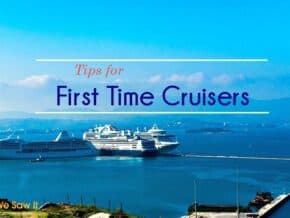
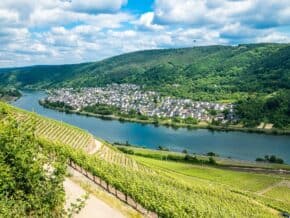
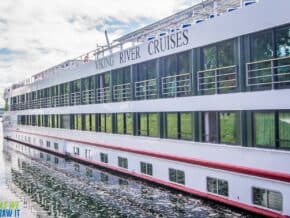
I like your philosophy of never wasting a day in life. Bamberg is certainly a top place to spend one. Nice post.
Thanks, Stuart. That cruise sure kept us busy – we didn’t waste a moment!
What is the best month to travel on the europe ?
We went in early June, but September would be nice as well, and daylight is still long enough. We prefer spring and fall, when school is in session and there are fewer tourist crowds.
It seems a nice tour and honestly, I would like to follow this itinerary. Thanks for sharing this post and on a very honest note, I got much information about the European cities and countries.
Glad it helped.
Thanks for the information, we are taking the Budapest to Amsterdam trip end of July on the Viking Modi. looks like Bratislava, Slovakia is no longer part of itinerary
Well dang, Larry & Maggie, you’re right! Instead, you get an extra day in Vienna. As much as we enjoyed our time in Slovakia, that seems like a fantastic trade-off. We were left longing for more with our single day in Vienna.
Come to think of it, we’ve seen day trips to Bratislava from Budapest online, and trains run regularly. Should be easy for one to fly in a couple of days early and see it as well.
Thanks for letting us know!
We are taking this cruise in June 2018 and reading your day to day journal is helpful in terms of what to expect each day. Thank you for sharing your adventure, it makes me even more excited about our trip.
You are more than welcome. We know you’ll have so much fun! (Do you mind if we admit to the tiniest bit of envy? We’d love to take that cruise again.)
I’ve seen comments about long bus rides at each port to get to the sites. Was that your experience on the Grand European Tour?
Well, yes and no. We docked in town at most of the Rhine and Danube stops. Those towns developed around the rivers, so naturally, ports are centrally located. Most of the trips that required bus rides were for towns on the Main Canal, because it was constructed recently and to preserve infrastructure and homes, they had to build it where space was still available.
The rides didn’t seem particularly long to us, though. Our guides gave us interesting orientations and we had wonderful scenery to enjoy on the way. (We napped and chatted on the way back.)
This itinerary looks pretty awesome. I had no idea the tours were quite so long and you get to see so many awesome places! I’d love to go on one of these cruises one day!
If you do go, you’ll be amazed. The staff is remarkable, the tours are excellent (and free), and the small passenger capacity makes it an intimate experience you will never forget.
You should go! River cruises are a fabulous experience. We can’t recommend them enough.
A Viking cruise is on our bucket list; thanks for the info. All the places look amazing. Now you have made me want to go even more.
I know what you mean. We want to take the Nile and Mekong cruises next.
Thank you so much for sharing your adventures. This has been very helpful because I will be cruising from Amsterdam to Budapest in April.
How did you pack all you needed in a carry-on and a back-pack? I would love to be able to do that.
Hi Bette, thanks for your question. Actually, I’ve been pondering writing a post about this.
In a nutshell, we always carry our valuables (camera and electronics) on board with us in our backpacks.
The biggest keys to packing light are to:
Enjoyed the information your post included. We are scheduled to take this cruise in July 2018 and you gave me a concise idea of what to expect each day. Also greatly appreciated your ideas on packing–this cruise will require different items than on a big ship in the Caribbean!
Thanks for the feedback! We’re so glad our post was so helpful. I hope our other posts for each destination were as useful and informative. 🙂
I am curious how you got permission to take pictures inside the Schönbrunn palace and the Milky Abbey. We were told it was absolutely not possible to take pictures while inside.
The only part of Melk Abbey that is off limits to photographers is the library. As for Schonbrunn, they forgot to tell our tour group that we couldn’t take photos until we had already taken shots of that one room. So we stopped.
I would love to do one of these river cruises and have been enjoying the posts taking note of how our small family of 3 would fare on such a cruise.
I think river cruises are best when children are old enough to appreciate sightseeing and history. Most little ones have far too much energy for a ship of that size and need more room to run and play.